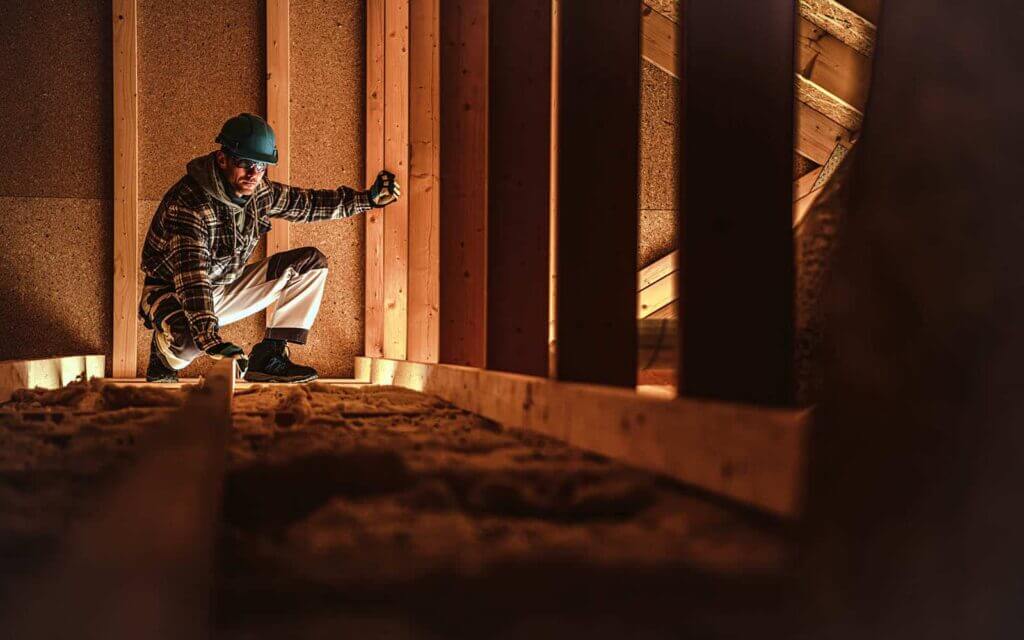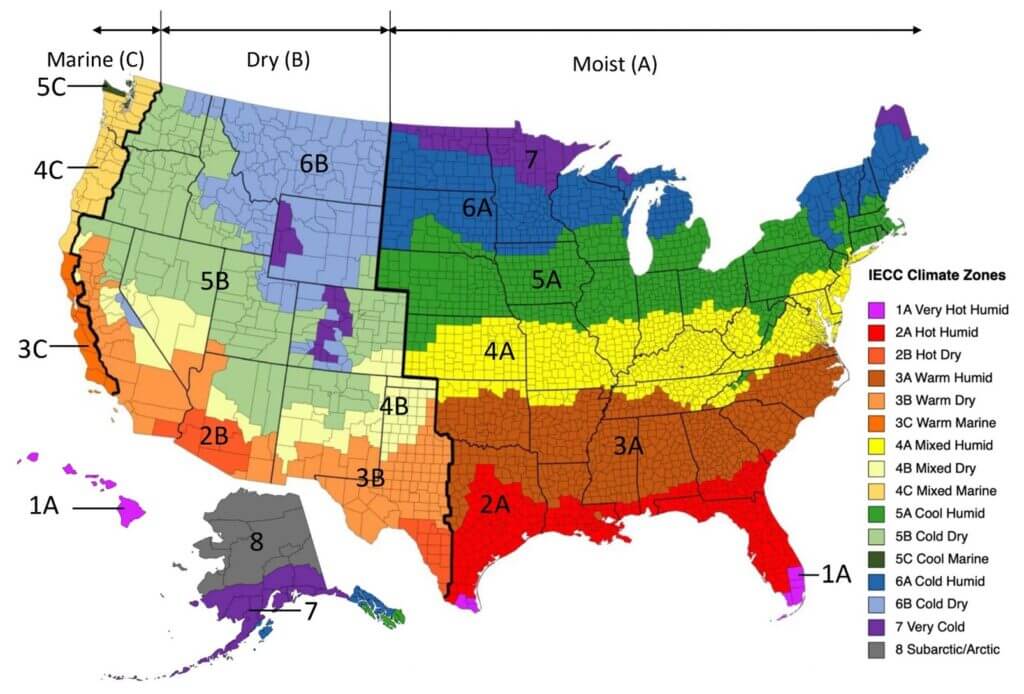What is attic insulation, and why is it important?
Attic insulation is any material installed between the roof decking of your home and the ceiling. This material may be foam or fiberglass, but more on that later.
Attic insulation reduces energy loss through conduction, air infiltration, radiation, and natural convection. When it’s hot out, you want to keep your home cool, and when it’s cold out, you want to keep your home warm; this is what attic insulation does.
If your home didn’t have attic insulation, your air conditioning unit and the furnace would continue to work overtime to maintain a comfortable temperature. That would be costly and wasteful.
The different types of attic insulation.
There are different types of attic insulation, and they’re made of different materials. In Texas, you typically find fiberglass batt, spray in, or blown-in insulation.

Fiberglass batt insulation is just that: fiberglass fibers compressed into batts. You’ve probably seen these in rolls at the hardware store or the pink fluffy stuff as you’re walking around your attic. It’s prevalent and relatively affordable.
Another common type is blown-in insulation; it consists of loose filling material, typically cellulose or foam. This type of insulation can be blown into hard-to-reach spaces using a particular machine. It does a great job at insulating, and installation is pretty inexpensive. It’s also a great option if you’re simply trying to add to your already existing attic insulation.
Spray-in insulation is foam insulation that’s sprayed into place. This type of insulation is typically the most expensive but provides the highest R-value. It’s great for filling gaps since it expands quickly and seals out air leaks.
Each of these types of insulation is measured in what is called an R-value. R-value is a measure of how well insulation resists heat flow. The higher the R-value, the better the insulation, the more you’re going to save on your energy bills. You’re probably going to pay more for a higher R-value as well, so keep that in mind as we discuss which is best for you.
How to choose the right type of insulation for your home.
Now that you have a general understanding of the various types of attic insulation, you’re probably wondering which is the best attic insulation for your Texas home.
Let’s start by acknowledging that Texas has its own unique weather compared to the rest of the US. There’s hot and dry desert on one side, while on the other side, it’s hot and humid. And then there’s the occasional snowpocalypse like what struck the Lone Star State in February 2021. In general, however, it’s hotter in Texas than most other states, which means you can get away with a lower R-value than homes in, say, Michigan.
This is because, for the most part, in Texas, you don’t have to worry about sub-zero winters (as often) as other places. When the temperatures are low, you’ll want your insulation to keep heat in. As we all know, heat rises, therefore leaves your home through the ceiling. Thicker insulation is consequently required in colder temperatures to help keep homes warm; in Texas, not as critical.
According to Energy Star, an EPA program that helps consumers identify the energy-efficient products that are right for them, Texas residents should insulate their homes between R30 and R60. They base this on the average temperatures within a region.
As we discussed, lower R-values will not perform as well as higher R-values, but they’ll be less expensive as well. As you’re considering the different types, you will want to balance performance against your budget. Sure, spray-in insulation at a high R-value is excellent and will perform well; it will cost you more than the others.
So what is the best attic insulation for homes in Texas?
Based on our experience, the best attic insulation for homes in Texas is blown-in fiberglass insulation. This insulation provides excellent insulating properties while being reasonably cost-effective compared to the other options. After all, you’re probably looking to upgrade your insulation to save money, so saving money on the installation makes sense.
Given that you need special equipment to install blown-in fiberglass insulation, you’ll probably need a professional to do the installation. It’s a quick and easy process if you have the equipment on hand and know what you’re doing.
Another downside of this insulation is losing its R-value over time. As the fiberglass chunks begin to settle, the insulating layer will get thinner and lose some of its insulating properties. That’s not to say it won’t last years, but compared to spray-in foam insulation, it won’t last as long.
Are you ready to upgrade your insulation?
If you’re looking for more information on different types of insulation or how to get the proper insulation for your home, contact us, we can help. We perform a range of services that can make your home more energy-efficient such as window installation and blown-in attic insulation. Our professionals understand what it takes to handle the rough Texas weather.
FAQ: Attic Insulation for Your Home
What is attic insulation, and why is it important?
Answer: Attic insulation is a material installed between the roof decking and the ceiling to reduce energy loss. It helps maintain comfortable temperatures in your home by reducing heat flow, preventing your HVAC system from working overtime, and saving on energy costs.
What are the different types of attic insulation?
Answer: Common types of attic insulation include fiberglass batt, blown-in insulation, and spray-in foam insulation. Fiberglass batt is affordable and widely available, blown-in insulation is great for hard-to-reach areas and adds to existing insulation, and spray-in foam offers the highest R-value but is more expensive.
What is R-value, and why does it matter?
Answer: R-value measures how well insulation resists heat flow. The higher the R-value, the better the insulation. Higher R-values typically result in better energy savings but also come at a higher cost.
What R-value is recommended for homes in Texas?
Answer: According to Energy Star, homes in Texas should have insulation with an R-value between R30 and R60, depending on the region and typical weather conditions.
How does Texas weather affect attic insulation needs?
Answer: Texas has a unique climate with hot, dry deserts, hot and humid areas, and occasional cold snaps. Generally, homes in Texas require lower R-values compared to colder states because the primary concern is keeping the home cool rather than warm.
What is the best attic insulation for homes in Texas?
Answer: Blown-in fiberglass insulation is recommended for Texas homes due to its excellent insulating properties and cost-effectiveness. However, it may lose some R-value over time as the fiberglass settles.
Can I install attic insulation myself?
Answer: While some types of insulation, like fiberglass batt, can be installed by homeowners, blown-in insulation typically requires special equipment and professional installation for optimal results.
How long does attic insulation last?
Answer: The lifespan of attic insulation varies by type. Blown-in fiberglass insulation can lose R-value over time as it settles, while spray-in foam insulation tends to last longer but is more expensive.
Why should I upgrade my attic insulation?
Answer: Upgrading your attic insulation improves your home’s energy efficiency, reduces energy bills, and maintains a comfortable indoor temperature. It can also lessen the strain on your HVAC system.
How can I get more information or schedule an insulation upgrade?
Answer: Contact us for more information on the types of insulation and to schedule a professional installation. We offer services to make your home more energy-efficient, including window installation and blown-in attic insulation.
What other services do you offer?
Answer: In addition to attic insulation, we provide a range of services to enhance your home’s energy efficiency, such as window installation and various insulation options tailored to the Texas climate.

